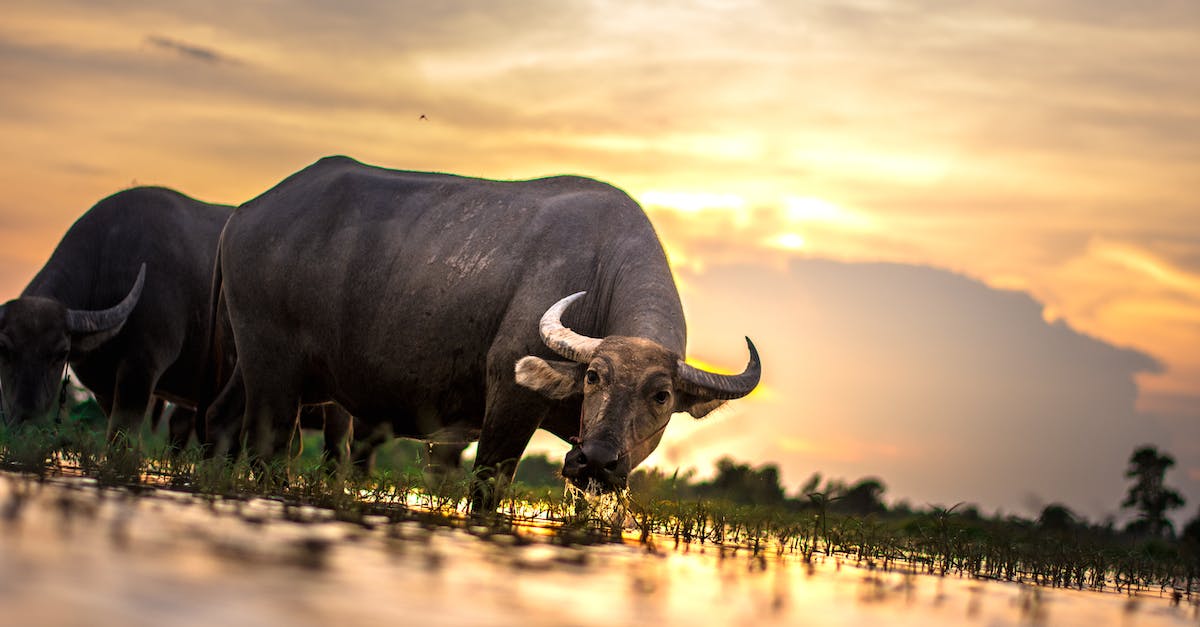The buffalo travel ban has become a hot topic of discussion in recent times. With its stunning landscapes and diverse wildlife, the buffalo has always been a popular tourist attraction. However, due to certain circumstances, authorities have imposed a travel ban on buffalo sightings in specific areas. This decision has sparked controversy and raised questions about the impact on tourism and the buffalo population. In this article, we will delve into the reasons behind the buffalo travel ban and explore its implications on both the local community and the visitors who flock to witness these majestic creatures. Let’s uncover the details and shed light on this pressing issue.
Reasons behind the Buffalo Travel Ban
The buffalo travel ban has been implemented due to several key reasons. These reasons are aimed at protecting both the buffalo population and the local community. Here are the main factors that have led to the implementation of the ban:
1. Conservation Efforts: The buffalo travel ban is a crucial step taken to ensure the conservation of the buffalo population. Buffalo are an important part of the ecosystem and play a vital role in maintaining the balance of the local environment. By restricting travel in areas where buffalo reside, their natural habitat is preserved, allowing them to thrive.
2. Protection of Public Safety: The safety of both visitors and the local community is another major reason for the buffalo travel ban. Buffalo are large, powerful animals that can be unpredictable and potentially dangerous if approached too closely or provoked. By implementing the ban, authorities are able to reduce the risk of human-wildlife conflicts and potential injuries to individuals.
3. Reduction of Disturbance: The ban also aims to minimize disturbance to the buffalo population. Frequent human activity and interaction can disrupt their natural behavior and patterns, leading to stress and potentially impacting their overall well-being. By limiting travel in buffalo-populated areas, it ensures a more peaceful environment for these magnificent creatures to exist undisturbed.
4. Preservation of Habitat: Buffalo rely on specific habitats for their survival. Over time, increased human activity and development have encroached upon these habitats, leading to a decline in suitable areas for buffalo to feed and roam. The travel ban helps protect these critical habitats, ensuring their availability for the buffalo and other wildlife species in the area.
5. Sustainable Tourism: The buffalo travel ban is also crucial for the long-term sustainability of tourism in the region. While tourism provides important economic benefits, it also has the potential to negatively impact the very attractions that draw visitors. By implementing the ban, the local authorities are taking proactive measures to ensure that tourism activities are managed more sustainably, allowing future generations to continue enjoying the beauty and diversity of the area.
These reasons behind the buffalo travel ban emphasize the importance of protecting the buffalo population and ensuring the well-being of both visitors and the local community. The ban serves as a vital conservation measure and contributes to the overall sustainability of the region.
Impact on Tourism Industry
The implementation of the buffalo travel ban has significant implications for the tourism industry in the region. While the ban prioritizes the protection of the buffalo population and the local community, it also affects the tourism sector that heavily relies on buffalo-related activities and attractions. Here are the key impacts of the ban on the tourism industry:
- Decrease in buffalo-related tourism: The ban restricts visitors from experiencing popular buffalo-related activities, such as guided tours, safari rides, and wildlife photography. This leads to a decline in tourist interest and potential revenue losses for businesses that offer these services.
- Shift in tourist preferences: With the ban in place, tourists may opt for alternative destinations or activities that do not involve buffalo encounters. This shift in preferences can lead to reduced footfall in the region, impacting local businesses dependent on tourism.
- Negative impact on local economy: The decline in tourist arrivals and spending has a ripple effect on the local economy. Businesses directly or indirectly linked to tourism, such as hotels, restaurants, souvenir shops, and transportation services, may experience financial difficulties.
- Transformation of tourism offerings: The ban necessitates adjustments in the tourism offerings to attract visitors. Tour operators and local businesses may need to diversify their services, promoting other local attractions, cultural experiences, or nature-based activities to compensate for the absence of buffalo-related activities.
- Opportunity for sustainable tourism: Despite the challenges, the buffalo travel ban opens opportunities for the development of sustainable tourism practices. Local communities can focus on promoting eco-tourism initiatives, emphasizing the natural beauty and biodiversity of the area, while educating visitors about conservation efforts.
- Collaboration with conservation organizations: The ban can encourage collaboration between the tourism industry and conservation organizations. By working together, they can implement alternative conservation-focused tourism initiatives that prioritize the well-being of the buffalo population and their habitat.
The implementation of the buffalo travel ban unavoidably impacts the tourism industry in the region. However, by adapting to the changes and focusing on sustainable practices, the industry can contribute to the long-term conservation efforts and the overall sustainability of the region.
Concerns for Buffalo Population
The buffalo travel ban has raised concerns for the buffalo population in the region. With restricted buffalo-related activities and attractions, there is a potential impact on the well-being and conservation of these majestic animals.
One major concern is the disruption of their natural habitat and migration patterns. Buffalos rely on their ability to roam freely in search of food and water. The travel ban limits their movement and forces them to remain confined to specific areas. This can lead to overcrowding and competition for resources, potentially affecting their health and overall population stability.
Another concern is the potential for increased human-wildlife conflicts. As tourists are discouraged from engaging in buffalo-related activities, there may be a decline in the number of people trained to deal with buffalo encounters. This could result in more instances of negative interactions between humans and buffalo, posing a risk to both parties.
Additionally, the buffalo travel ban could impact the breeding patterns of these animals. Buffalo populations rely on mating rituals and territorial behavior, which can be disrupted when their movement is restricted. This could potentially lead to a decrease in the number of successful breeding pairs and a decline in the overall buffalo population.
Furthermore, the tourism industry has played a significant role in funding conservation efforts for buffalo populations. With the decrease in tourist interest due to the travel ban, there may be a reduction in financial resources available for conservation and protection programs. This could hinder the long-term sustainability and conservation of the buffalo population in the region.
The buffalo travel ban raises concerns for the buffalo population, including disruptions to their natural habitat, increased human-wildlife conflicts, impacts on breeding patterns, and potential financial setbacks for conservation efforts. These concerns highlight the need for careful management and collaboration between the tourism industry and conservation organizations to ensure the well-being and long-term sustainability of the buffalo population.
Controversy Surrounding the Travel Ban
The implementation of the buffalo travel ban has sparked a significant amount of controversy within the region. While some argue that the ban is necessary for the protection of the buffalo population, others believe that it is an overreach of authority that will have severe negative impacts on the tourism industry and the local economy.
Opponents of the travel ban emphasize the adverse effects it has on businesses that heavily rely on buffalo-related activities and attractions to attract tourists. With restrictions in place, these businesses are experiencing a decrease in visitor interest and potential revenue losses. As tourists realize that they can no longer engage in activities like buffalo viewing tours or visit buffalo-themed parks, they may opt for alternative destinations or activities, leading to reduced footfall and negative effects on the local economy.
Furthermore, critics argue that the ban disrupts the delicate balance between conservation efforts and tourism. They claim that banning buffalo-related activities without providing alternative experiences for tourists to engage with wildlife can result in increased human-wildlife conflicts. With limited opportunities to observe and appreciate buffalos in their natural habitat, tourists may attempt to approach these animals in unauthorized ways, leading to potentially dangerous situations.
Additionally, the ban brings forth concerns about the long-term effects on the buffalo population itself. The restrictions imposed by the ban may disrupt the natural habitat and breeding patterns of the buffalos, potentially leading to population decline. This not only affects the ecological balance within the region but also poses financial setbacks for conservation efforts aimed at maintaining a stable buffalo population.
While controversy surrounding the buffalo travel ban remains, it is clear that careful management and collaboration between the tourism industry and conservation organizations are crucial to ensure the well-being and long-term sustainability of the buffalo population. By finding a middle ground that allows for both the protection of the buffalo and the continuation of responsible tourism practices, it is possible to mitigate the negative effects of the ban while preserving the natural heritage and economic benefits of the region.
The Local Community’s Perspective
The local community plays a crucial role in the debate surrounding the buffalo travel ban. Many people in the area rely heavily on tourism as a source of income, and they believe that the ban has had a significant negative impact on their livelihoods. Here are some key points from the local community’s perspective on the issue:
- Economic Implications: Tourism is a vital industry for the local community, with many businesses dependent on visitors who come to see the majestic buffalo herds. From hotels and restaurants to souvenir shops and tour operators, local businesses have seen a decline in revenue since the implementation of the travel ban. This has led to job losses and financial uncertainty for many individuals and families in the area.
- Alternative Wildlife Experiences: Opponents of the ban argue that without the opportunity to observe and interact with buffalo, tourists may seek out other wildlife encounters or attractions in nearby regions. This could potentially divert tourism away from the local community, resulting in further economic losses. Furthermore, alternative wildlife experiences may not have the same level of conservation oversight, potentially impacting the broader ecosystem.
- Human-Wildlife Conflicts: The local community also raises concerns about the possible increase in human-wildlife conflicts due to the ban. Without alternative ways for tourists to connect with nature, there may be a higher likelihood of visitors venturing into restricted areas or engaging in risky behaviors to get close to wildlife. This could pose risks to both human safety and the well-being of the buffalo herds.
It is important to acknowledge and address the concerns of the local community in the ongoing discussion about the buffalo travel ban. Balancing the economic needs of the community with the conservation efforts for the buffalo population is crucial for finding sustainable solutions that meet the interests of all stakeholders involved. By fostering open dialogue and considering alternative ways to support the local economy while protecting wildlife, it is possible to find a compromise that benefits both the community and the buffalo population.
Conclusion
The buffalo travel ban has sparked a heated debate with significant implications for both the local community and the buffalo population. The ban has had a detrimental effect on the tourism industry, leading to job losses and financial uncertainty for many individuals and families who rely on tourism as their main source of income. Moreover, opponents argue that the ban may divert tourists to other wildlife encounters or attractions in nearby regions, further impacting the local community’s economic stability. Additionally, concerns have been raised regarding potential human-wildlife conflicts that may arise due to the ban.
It is clear that finding a balanced approach that considers the economic needs of the community while protecting the buffalo population is crucial. Collaborative efforts between stakeholders, including local authorities, tourism organizations, and wildlife conservation groups, are essential in order to address these concerns and ensure the long-term sustainability of both the local economy and the buffalo population. By working together, it is possible to find solutions that benefit all parties involved and ensure the preservation of this iconic species for future generations.
Frequently Asked Questions
Q: What is the controversy surrounding the buffalo travel ban?
A: The controversy centers around the ban on buffalo travel, which has had a negative impact on the tourism industry and the local community who rely on it for income.
Q: How has the ban affected the tourism industry and the local community?
A: The ban has resulted in job losses and financial uncertainty for many individuals and families in the area, as tourists are unable to observe and interact with buffalo.
Q: Are there any economic implications of the ban?
A: Yes, the ban has led to a diversion of tourism away from the local community, as tourists may seek out other wildlife encounters or attractions in nearby regions.
Q: What other concerns are raised about the ban?
A: One of the concerns is the potential increase in human-wildlife conflicts due to the ban, as tourists may try to interact with buffalo illegally.
Q: What approach is needed to address the controversy?
A: A balanced approach is needed that considers the economic needs of the community while also protecting the buffalo population.




